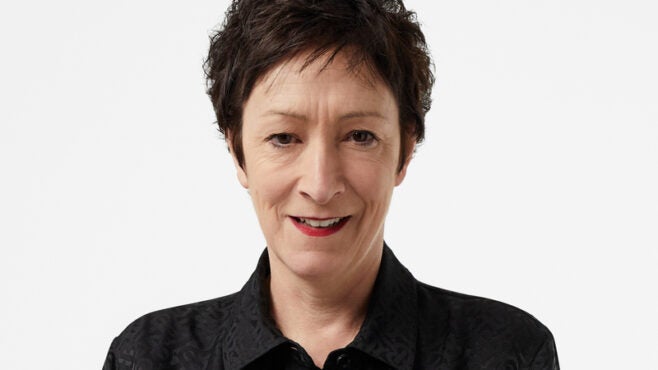

- Burberry was the first house in the emissions-heavy fashion industry to sell a sustainability bond, a £300m ($411.1m) five-year issue in September last year.
- On top of making major Scope 1 and 2 carbon cuts, the company had aimed for a 30% reduction of Scope 3 emissions by 2030 but has raised target to 46%.
- Long-standing relationships with its suppliers have made achieving the Scope 3 target easier, says Burberry CFO Julie Brown.
The fashion industry does not get regularly called out as a big polluter as do, say, the energy or transport sectors. And yet it accounts for 10% of global carbon emissions, according to the World Bank – more than all international flights and maritime shipping combined.
What’s more, microplastics from polyester and acrylic fibres used in clothing have contaminated multiple shorelines across six continents. The addition of smaller, recently discovered particles, has raised global estimates of surface microplastics to between 12trn-125trn particles, according to research conducted by the UK’s Plymouth Marine Laboratory.
British charity the Ellen MacArthur Foundation says around 20% of wastewater worldwide comes from fabric dying and treatment, less than 1% of used clothing is recycled, and 87% of the fibres used for clothing end up in landfill.
No wonder activist Greta Thunberg, in early August, called fashion “a huge contributor to the climate and ecological emergency” on Twitter and singled it out in an interview in Vogue Scandinavia.
But greenwashing is “rampant” in the sector, wrote Nuša Urbancic, campaigns director of Dutch non-profit group the Changing Markets Foundation in a letter to the Financial Times on 20 August. Claims of using ‘sustainable’, ‘preferred’, ‘sustainably sourced’ or ‘sustainably made’ materials are “often ill-defined and constitute unsubstantiated claims that mislead consumers”, she said.
It’s perhaps not surprising, then, that fashion businesses have made little use of green or sustainable financing. Only companies at the luxury end have done so.
In July last year, Italian brands Moncler and Salvatore Ferragamo took out €400m ($470.7m) and €250m loans, respectively, with margins linked to ESG targets. And Milan-based fashion house Prada has inked three sustainability-linked loans: a €50m five-year deal with Crédit Agricole in November 2019, a €75m transaction with Mizuho in January 2020 and a €90m five-year loan with UniCredit in February this year. The key performance indicators on all three trades are based on the reduction of Scope 1 and 2 emissions and of waste.
First on the catwalk
But one company has distinguished itself from the crowd in particular style. London-based luxury fashion house Burberry was the first of its peers to issue a sustainability bond, with a massively oversubscribed £300m ($411.1m) 1.125% five-year deal on 14 September last year.
The industry’s only sustainable bond issuers since then have been France’s Chanel with a €600m dual-tranche five and ten-year sustainability offering and German sportswear giant Adidas with a €500m eight-year sustainability bond, both in late September 2020.
Issuing a sustainable bond fitted Burberry’s “longer-term objectives”, says Julie Brown, Burberry’s chief operating officer and chief financial officer. The Covid-related downturn that took hold last year was a key reason the extra funds were needed. But the deal had a positive knock-on effect as it spread the sustainability message through the group, she adds.

Raising debt would typically largely fall under the finance team’s remit. But, as a sustainability bond, the deal “became the domain of multiple functions in the organisation”, Brown says. It even concerns Burberry’s customers and suppliers, as the company has set an ambitious target for cutting its Scope 3 emissions – those connected with a company but outside its direct control.
The transaction also reflects a desire to show an increased focus on sustainability. The 165-year-old firm suffered bad press in 2018 after reports emerged that it had destroyed £28.6m of unsold clothes, accessories and perfume to protect its brand.
“We made the commitment in 2018 to end the practice [of destroying goods],” says Pam Batty, head of corporate responsibility. Burberry works hard to “to manage inventory”, she adds. It has partnerships around the world for recycling, repurposing or donating unsold finished products.
Burberry says it is confident of achieving its target of using 100% renewables-generated electricity for its own operations by next year.
Investors were certainly sold. There was more than eight times the volume of orders than paper available, says Brown. But she decided not to upsize the issue, which was rated Baa2 by Moody’s, as “we didn’t need the additional money”.
It drew a combination of typical capital market allocators and ESG-focused funds, she adds. Second-party opinion provider Sustainalytics described the company’s Sustainability Bond Framework as “credible and impactful”.
“If we felt there was a need to raise [further] funding… we would certainly go down this route again,” says Brown.
Ambitious emissions targets
A year on, and Burberry’s use of proceeds have not only met its sustainability goals, but in some cases the firm has raised the targets.
The company said ahead of the bond issue it wanted to achieve a net zero-carbon footprint for its operational energy by 2022 – that is, reduce its Scope 1 and 2 emissions. It had planned to do so by cutting absolute emissions, improving energy efficiency, switching to renewable energy sources and then offsetting any remaining emissions.
You can’t hide behind things like offsetting; you have to make the absolute reductions. Pam Batty, Burberry
However, in light of the controversy around carbon offsetting – effectively, that the practice is seen as simply moving emissions around – Burberry dropped that part of the strategy in favour of targeting real reductions. “You can’t hide behind things like offsetting; you have to make the absolute reductions,” says Batty.
Between 31 March 2020 and June this year, Burberry increased the share of power generated from renewable energy sources in its factories to 93% from an already impressive 86%. The company says it is confident of achieving its target of using 100% renewables-generated electricity by next year.
Arguably even more notable is Burberry’s approach to Scope 3 emissions. The company had originally set itself a target of reducing the emissions from its supply chain by 30% by 2030. But in early June this year it raised that goal by 46% to align itself with the 2015 Paris Agreement objective of preventing the global temperature from rising by more than 1.5°C.
Scope 3 is recognised as one of the hardest emissions-related metrics to improve, but “long-standing relationships make [the task] easier”, says Brown. For instance, one of Burberry’s suppliers of cashmere scarves in Scotland has been supplying the company for a century.

“It’s not a really big sell,” Batty explains. It is a case of talking to and supporting suppliers as they transition to greater efficiency or renewable energy in their manufacturing. Indeed, she says, Burberry has not had to sever relationships with any companies because of an unwillingness to commit to emissions reduction.
There is, Batty adds, “a common shared agenda that’s building across the industry”, particularly within luxury fashion, around the importance of sustainability. “We’re not the only brand asking the supply chain to think about these things.”
Supply chain sourcing
Burberry, which has metrics around key data such as emissions and sourcing validated by auditor PwC, has other sustainability goals for its supply chain. “We’ve got a clear objective now to have 100% of key raw materials traceable and from certified sources by 2025,” says Brown. “That includes cotton, recycled polyester, nylon and wool.”
Burberry sources its cotton, for example, with the help of global non-profit the Better Cotton Initiative, the largest cotton sustainability programme in the world. Moreover, the company intends to use 100% certified organic cotton by 2025.
“This holds environmental and social benefits and is traced through our supply chain via a chain of custody,” Brown adds. The supply chain for cotton, much of which is traded through opaque commodity exchanges, faces many challenges, not least of which is child labour.
Modern slavery is a major issue in the fashion and textiles industry, as some institutional investors have noted. Burberry was a founder of the industry pressure group Business Against Slavery Forum and is a partner with anti-trafficking non-profit organisation the Issara Strategic Partner Programme.
Meanwhile, Burberry aims to source all of its leather from tanneries that have environmental, traceability and social compliance certifications by next year. Traceability of leather in its supply chain has already improved from 64% in 2019/20 to 80% in the past financial year.
The company has achieved all this mostly through “working really closely with our tanneries, which are almost entirely in Italy”, says Batty.
As a brand sought after by young, wealthy and image-conscious consumers, Burberry is well aware of the value of being seen as green. Sustainability is front and centre of the company’s website and forms part of its “ultra-savvy marketing drives”, says Susannah Streeter, senior investment and markets analyst at London-based investment platform Hargreaves Lansdown.
For a company that appears to be living up to its sustainability pledges, such admiration is justified. And few are better placed to spread the good word.





